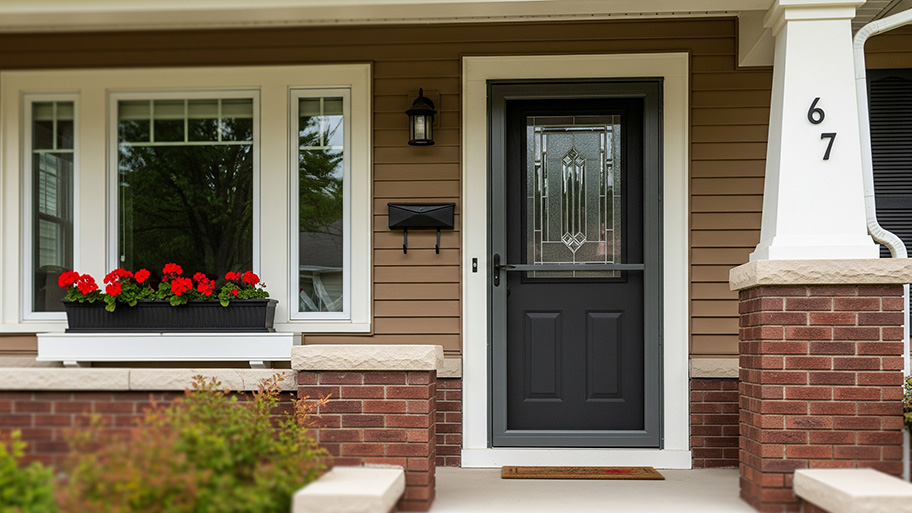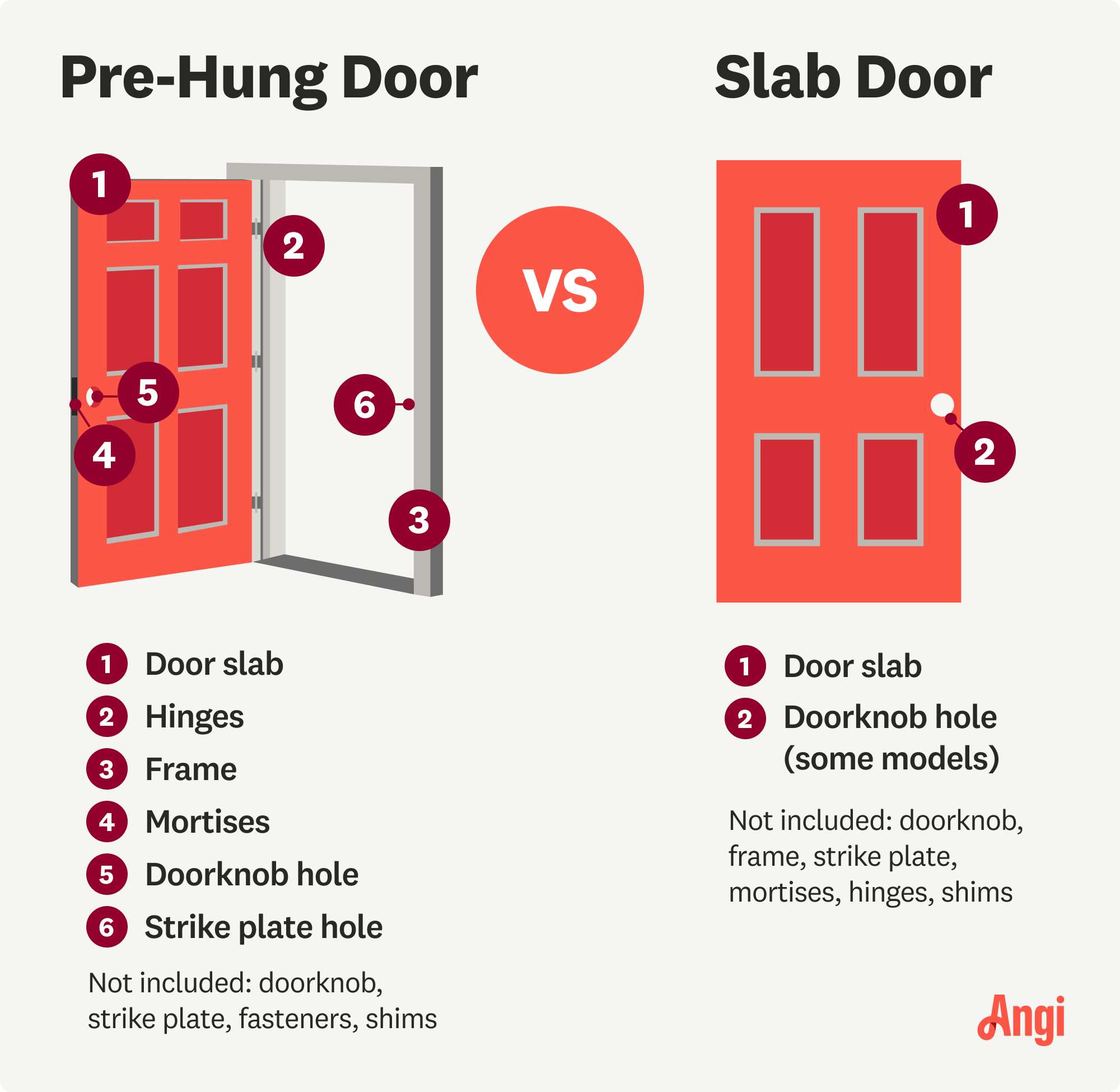
A storm door can protect your front door and let in more fresh air. Find out how much storm door installation costs for materials, labor, and more.
Pre-hung doors save you trouble but may not always fit your wall opening


Pre-hung doors include the doorframe already attached to the door.
Pre-hung doors are easier to install and are better suited for DIY installation.
Slab doors come in more size options but include fewer materials.
Slab doors cost $60 to $300, while pre-hung doors cost $125 to $400, not including labor.
Whether you’re installing a new door or replacing one, you’ll need to decide if a slab door or a pre-hung door is the right option for you. The two differ in cost and DIY-ability, so whether you’re hiring a pro or not will be a big factor. This guide discusses the differences between a pre-hung and a slab door and how to choose the best one for your home.

The primary difference between these two types of doors is what they include. A slab door is just the door by itself, meaning you’ll have to install your own hinges and make sure it’s level when you attach the hinges to your doorframe.
A pre-hung door is already attached via hinges to the doorframe, which comes with the door. Installation is easier since you just level the frame and attach it rather than having to hang the door as well.
A slab door is a standalone door that you buy without a frame. Before installing a slab door, you should already have a doorframe installed and shimmed inside your wall opening.
To install it, you’ll need to screw hinges into the door, prop the door up so it’s plumb, level, and centered in your wall opening, and then screw the hinges into the frame. This type of door is more difficult to DIY, so call a door installer if you’d like them to complete the installation.
| Pros | Cons |
|---|---|
| Less costly | More challenging to install |
| More sizes are available | Requires additional work to prep or install the frame |
| Doesn’t require installing a new doorframe | Frame repairs are necessary |
| Fewer manufacturer defects | The installation requires additional tools |
A pre-hung door comes pre-hung on a frame. Instead of just a standalone door, you also get the three-piece frame—two sides and a header—where the door will sit. The hinges are already attached to the door and the frame and should be perfectly spaced and plumb.
If you want to put in a new door yourself, installing a pre-hung door is easier than using a slab door.
| Pros | Cons |
|---|---|
| Simpler to DIY | Fewer sizes are available |
| Fewer tools required | Costs more than slab doors |
| No frame repairs required | You’ll have to shim the frame in place |
| Brand-new door and visible frame | Manufacturer defects are more common |
Pre-hung and slab doors both have merits, so consider the following comparison points when choosing the door that’s right for your project.
New slab doors and pre-hung doors will, of course, look new and fresh. However, a pre-hung door tends to look better overall because you get a brand-new door and a fresh doorframe. The frame and door will match perfectly in material and color, and there’s no risk of a damaged or worn frame, which can’t be said for a slab door.
A slab door will always be less expensive than a pre-hung door because it includes fewer materials and is easier to manufacture. A slab door doesn’t include the frame material or hinges and doesn’t require hanging during manufacturing.
The cost of a slab door ranges from $60 to $300 in most cases, while a pre-hung door costs between $125 and $400 for the materials alone. Keep in mind that these prices don’t include the labor cost of door installation.
A pre-hung door is a DIYer's dream: You get to tackle your own home improvement project, but the process is simpler. Here are a few of the steps you would follow when installing a slab door that aren’t required when installing a pre-hung door:
Routing out an area for the hinges in the door and frame
Attaching the hinges
Making sure the hinges are plumb and the door sits level inside the frame
When you buy a pre-hung door, you simply shim the door, make sure the frame is spaced properly, and attach it to your wall framing. A slab door installation will most likely require the help of a door installer near you.
A slab door tends to have more size options than a pre-hung door, so it’s probably the better option if you live in an older home that doesn’t have today’s standard-sized wall openings for doors or if your home has custom doors. You can order a fully custom slab door, which isn’t usually an option for a pre-hung door.
The quality of both a slab door and a pre-hung door is about equal, but the risk of a manufacturer defect is higher for a pre-hung door. During manufacturing, more can go wrong if the manufacturer needs to hang a door inside a frame and ensure that it’s perfectly level and plumb before shipping. Pieces of the frame can shift during shipping, leading to a poorly hung door when you install it.
Both slab doors and pre-hung doors are pretty straightforward to repair, mainly because you can simply remove a pre-hung door and replace it with a slab door if you need to. Provided the door is installed properly, repairs aren’t common for either type of door.
Replacing an interior door with a pre-hung or slab door will add about the same value to your home. Most buyers won’t be able to tell the difference between a pre-hung door and a slab door once it's installed unless your existing doorframe is visibly older than the slab door you installed.
According to data from Angi, 38% of homeowners are looking to install an interior door within two weeks, while 29% of homeowners need door installation within one to two days. The remaining homeowners are either still planning or can wait more than two weeks.
From average costs to expert advice, get all the answers you need to get your job done.

A storm door can protect your front door and let in more fresh air. Find out how much storm door installation costs for materials, labor, and more.

French doors upgrade your space and fill it with natural light. Use this guide so that you can accurately budget the cost to install French doors.

The cost to install a pocket door includes a few more line items than other designs. Here's what to expect from pocket door costs at each stage in the process.

French doors are an elegant way to let light in and provide access to the side or rear of your home. Learn what French doors are and why they’re so popular.

If you’re unsure how to repair a door jamb, we’ve got steps for the most common problems and to transform your door from an eyesore to a welcoming friend.

Learn how to identify and prevent water from leaking through your sliding glass door with a few easy, effective solutions.